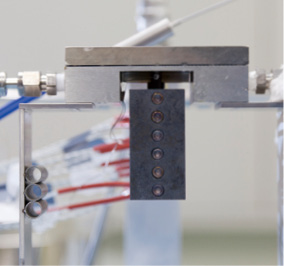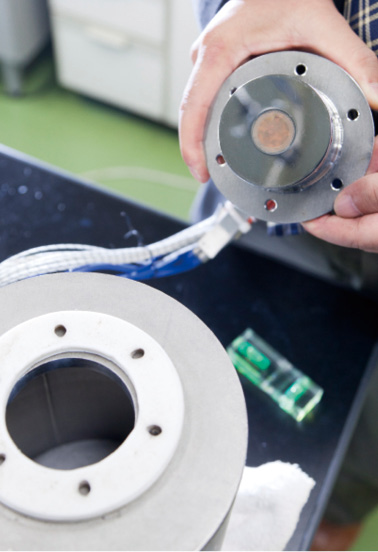
As of August, 2015
| Faculty/Department | Department of Mechanical Engineering and Intelligent Systems Graduate School of Informatics and Engineering |

|
| Members | Tomio Okawa, Professor | |
| Affiliations | Japan Society of Mechanical Engineers; Atomic Energy Society of Japan; Japanese Society for Multiphase Flow; Heat Transfer Society of Japan | |
| Website | http://www.eel.mi.uec.ac.jp/ | |
Thermal hydraulics; multiphase flow; gas-liquid two-phase flow; air bubbles; droplets; liquid film; spray; heat transfer with phase change; boiling; condensation; critical heat flux (CHF); thermal hydraulics in nuclear power plant; fuel cell; electronic equipment cooling; carbon dioxide capture and storage (CCS)
Our laboratory undertakes studies to clarify our understanding of the physical mechanisms that dominate the temporal evolution of thermal hydraulic phenomena and gas-liquid interface structures, such as milk crowns, under conditions in which liquid and gas coexist. Our goal is to establish the basic technologies required to build safe and highly-efficient next-generation energy systems.
In thermal power plants and nuclear power plants, power is generated by vapor at high temperature and pressure. More precisely, the heat produced by the combustion of fossil fuels such as petroleum, coal, and natural gas in thermal power plants and the heat produced by nuclear fission reactions in nuclear power plants are used to boil water and produce the high-temperature, high-pressure vapor needed to rotate turbines and generate electricity.
Since liquid water changes into vapor in such systems, water in both liquid and vapor phase must coexist at some point in time, creating a multiphase system. Substances generally occur in three phases: solid, liquid, or gas. Flows consisting of two or more phases are called multiphase flows. The special multiphase flow case in which the two phases present are gas and liquid is called a gas-liquid two-phase flow. Problems of heat transfer and flow within a system involving only liquid water or air, called single-phase flows, are already quite difficult to investigate; the extreme difficulties posed by thermal hydraulic phenomena in multiphase or gas-liquid two-phase flows should be obvious.
If the amount of vapor is excessive, as in the case of thermal or nuclear power plants, it has been found that liquid films form on the wall surface of the flow channels and that vapor flows through the central area of the channel. This is called annular flow because the cross section of the liquid film is ring-shaped. In power generation plants, heat is applied to the tube walls to ensure that the walls remain wetted. Loss of this liquid film would result in a rapid increase in temperatures at the tube walls and the risk of melting, in the same way empty kettles left on a fire overheat to dangerously high temperatures. These conditions can result in serious damage to a power plant. The dangerous state in which this liquid film is lost is called a dryout, and the power output at dryout is known as the critical power. Since dryouts must be avoided, the most vital issues in designing the thermal hydraulics of a plant involve accurate predictions of critical power.
Liquid droplets are constantly being generated on, and torn from, the surface of the liquid film into high-speed vapor flow, a phenomenon known as entrainment. While this may inspire a powerful image like “The Great Wave off Kanagawa (Kanagawa-Oki Nami-Ura),” the Katsushika Hokusai woodblock, the phenomenon represents a major issue in power plants, since entrainment reduces the liquid film and makes dryouts more likely. Assessments of entrainment volume are an important step in predicting critical power. Our laboratory has made dramatic progress in improving the accuracy of these predictions based on thorough examination of the mechanism that generates entrainment.
Our research also seeks to create high-performance energy devices based on our knowledge of the behavior of the gas-liquid interface. Examples include developing technologies to improve the cooling limit of power electronic devices such as semiconductor units (e.g., CPUs, power invertors) by modifying the design of the coolant channel; developing technologies to dramatically improve the heat removal limit by dispersing nano-meter-sized particles within a liquid; and developing technologies to prevent the accumulation of liquid within the flow channel by controlling the wettability of the channel wall, thereby contributing to stable power output from fuel cells.

Gas-liquid two-phase flows are extremely complex. Most approaches to such problems are based on rules and techniques established through experiment and experience. However, the remarkable progress in measurement technologies in recent years, made possible by high-speed cameras, has led to a dramatic leap in numerical simulation technologies. Our laboratory hopes to break from conventional empirical studies to tackle detailed investigations of the vital microscopic processes associated with gas-liquid two-phase flows, based on visualization experiments and numerical simulations.
One example of the results of these studies is the successful elucidation of the principle underlying a longstanding mystery: the significant increase observed in critical power when a spacer, a jig used to fix the fuel rods in place, is deployed in nuclear power reactors. We investigated the effects of the spacer by placing an obstacle simulating a spacer within a flow channel to assess the changes in the flow volume of liquid film in the annular flow. Our results showed that collisions between liquid droplets and the spacer contribute to a significant increase in critical power.

With annular flow, it has been assumed that liquid droplets continually collide with the liquid film and that most droplets are absorbed by the film after these collisions. Experiments have shown instead that a droplet made to fall on a surface of water produces new droplets after the collision. If so, are the droplets in the annular flow absorbed? We began by focusing on differences in incident angles. While droplets fall nearly perpendicularly onto a surface, the incident angle between a droplet in the phenomenon of annular flow is oblique. We observed both perpendicular and oblique collisions by reproducing them in experiments, thereby overcoming the technical difficulties posed by the latter.
The results for oblique collision experiment at a 45° angle were stunning. Contrary to expectations that oblique collisions would reduce droplet formation, these collisions produced nearly 100-fold more droplets by volume than perpendicular collisions, which would lead to reduced, not increased, liquid film flow rates after collisions. A picture is indeed worth a thousand words.
Reducing the angle of incidence, we found that the droplet formation was dramatically suppressed at angles of less than 20°. Since the angle of collision is normally 2-3° of the axis of annular flow, we can expect droplet formation to be minimal. We have yet to confirm our assumption that droplets are absorbed by the liquid film after collisions. We plan to accumulate more data from experiments performed at small angles of incidence.
Boiling has been described as both an everyday phenomenon familiar to all and an example of the complex phenomena likely to remain forever beyond complete understanding. It is human nature to find a good challenge irresistible; we attempted to observe an especially difficult case in which flow is present and the water in question is cold. This type of boiling is known as forced convection subcooled boiling, an important phenomenon with implications for the safety of nuclear power plants and cooling of heat-releasing components such as CPUs. One accepted theory of forced convection subcooled boiling in circulation since the 1960s states that the mode of flow is changed dramatically by the presence or absence of air bubbles formed on the tube walls by surface tension. We observed no air bubble formation on the tube walls and concluded that the dramatic changes in flow mode can be attributed to dynamic properties at microscopic scales far smaller than those of air bubbles.
Society is likely to rely more heavily in the coming years on thermal power generation based on new forms of fossil fuels such as shale gas and methane hydrates, in addition to petroleum, coal and natural gases, making efforts to reduce greenhouse gas emissions even more pressing.
At our laboratory, we plan to develop safe, highly efficient methods for supplying energy while developing methods to minimize the carbon dioxide produced by power generation. One theme that interests us is carbon dioxide capture and storage, or CCS. In one CCS process, a special liquid is used to absorb the carbon dioxide produced at a thermal power plant, after which the carbon dioxide is subsequently separated and recovered, ultimately to be stored underground or below the seafloor. We hope to apply our expertise in gas-liquid two-phase flow to these processes and to make worthwhile contributions to the development of CCS technologies.